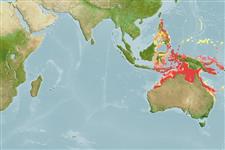Common names from other countries
Environment: milieu / climate zone / depth range / distribution range
Ecologia
marino associati a barriera corallina; distribuzione batimetrica 5 - 100 m (Ref. 6390). Tropical; 21°N - 28°S, 117°E - 159°E (Ref. 5222)
Western Pacific: Thailand, Singapore, Philippines, Indonesia, Papua New Guinea, the Arafura Sea (Ref. 9819), Solomon Islands, and Australia (from Houtman Abrolhos in Western Australia to Gladstone, Queensland) (Ref. 3150). This species was formerly listed as occurring in the western Indian Ocean based on a misidentification of Plectropomus pessuliferus.
Length at first maturity / Size / Peso / Age
Maturity: Lm ? range ? - ? cm
Max length : 125 cm TL maschio/sesso non determinato; (Ref. 90102); peso massimo pubblicato: 25.0 kg (Ref. 5222)
Spine dorsali (totale) : 7 - 8; Raggi dorsali molli (totale) : 10 - 12; Spine anali: 3; Raggi anali molli: 8.
Found in protected coastal reef in mixed algae and coral habitat (Ref. 48635). Common on inshore coastal reefs but absent in clear offshore reefs (Ref. 9710). Juveniles have a demersal existence in shallow water in reef habitats, especially around coral rubble (Ref. 27259). Migrate over short distances to spawn, forming aggregations (Ref. 6390). May move into shallow water to feed (Ref. 6390). Eggs float just below the water surface (Ref. 6390). Pelagic larvae are found in habitats similar to those of the adults (Ref. 27260). Juveniles feed on small fish and invertebrates such as crustaceans and squid (Ref. 27261). Commonly used for food. Its flesh is delicate and well appreciated (Ref. 5503). Solitary (Ref 90102).
Confirmed for diandry (Ref. 103751).
Heemstra, P.C. and J.E. Randall, 1993. FAO Species Catalogue. Vol. 16. Groupers of the world (family Serranidae, subfamily Epinephelinae). An annotated and illustrated catalogue of the grouper, rockcod, hind, coral grouper and lyretail species known to date. Rome: FAO. FAO Fish. Synop. 125(16):382 p. (Ref. 5222)
IUCN Red List Status (Ref. 130435)
CITES (Ref. 128078)
Not Evaluated
Threat to humans
Reports of ciguatera poisoning (Ref. 30298)
Human uses
Pesca: commerciale; Acquacoltura: commerciale; Pesce da pesca sportiva: si
Strumenti
Special reports
Download XML
Fonti Internet
Estimates based on models
Preferred temperature (Ref.
115969): 26.1 - 28.8, mean 27.8 (based on 466 cells).
Phylogenetic diversity index (Ref.
82804): PD
50 = 0.5078 [Uniqueness, from 0.5 = low to 2.0 = high].
Bayesian length-weight: a=0.01122 (0.00581 - 0.02169), b=3.05 (2.89 - 3.21), in cm Total Length, based on LWR estimates for this species & (Sub)family-body (Ref.
93245).
Trophic level (Ref.
69278): 4.1 ±0.70 se; based on food items.
Resilienza (Ref.
120179): Medio, tempo minimo di raddoppiamento della popolazione 1.4 - 4.4 anni (K=0.21; tm=2-3).
Fishing Vulnerability (Ref.
59153): Moderate to high vulnerability (51 of 100).
